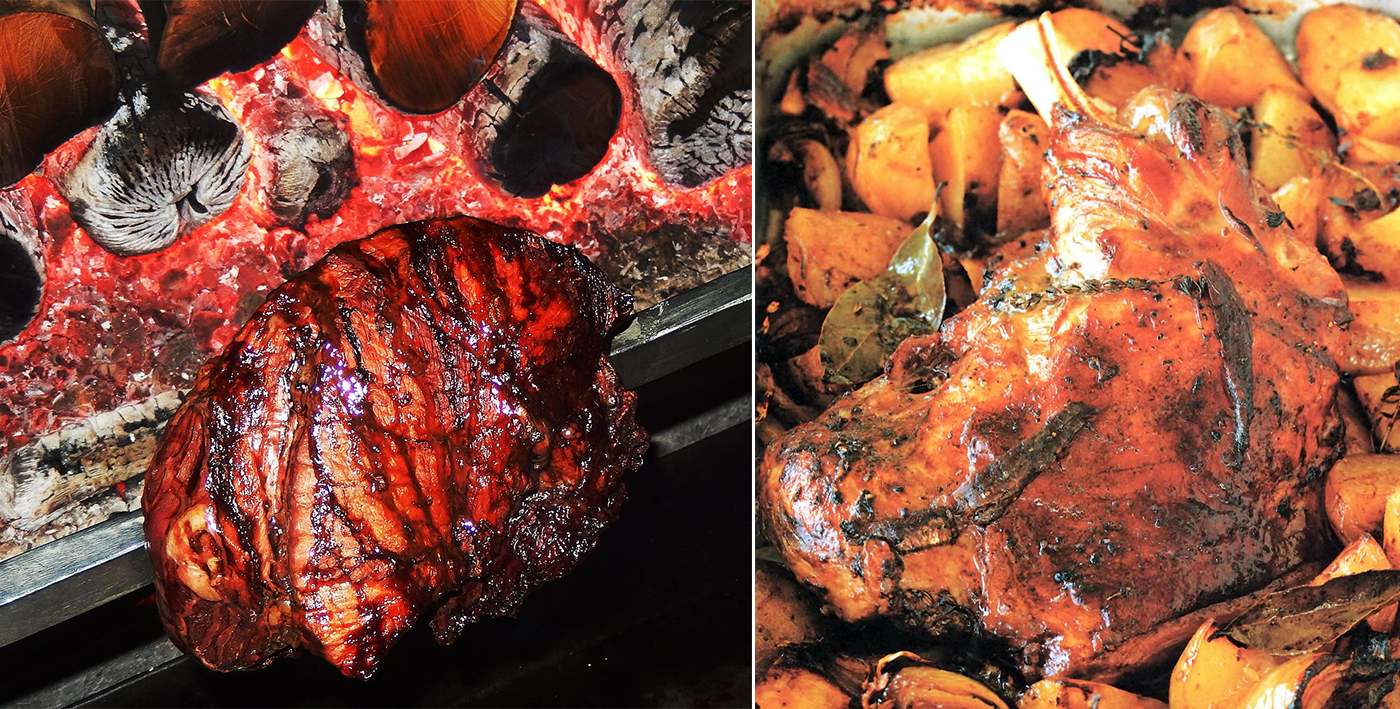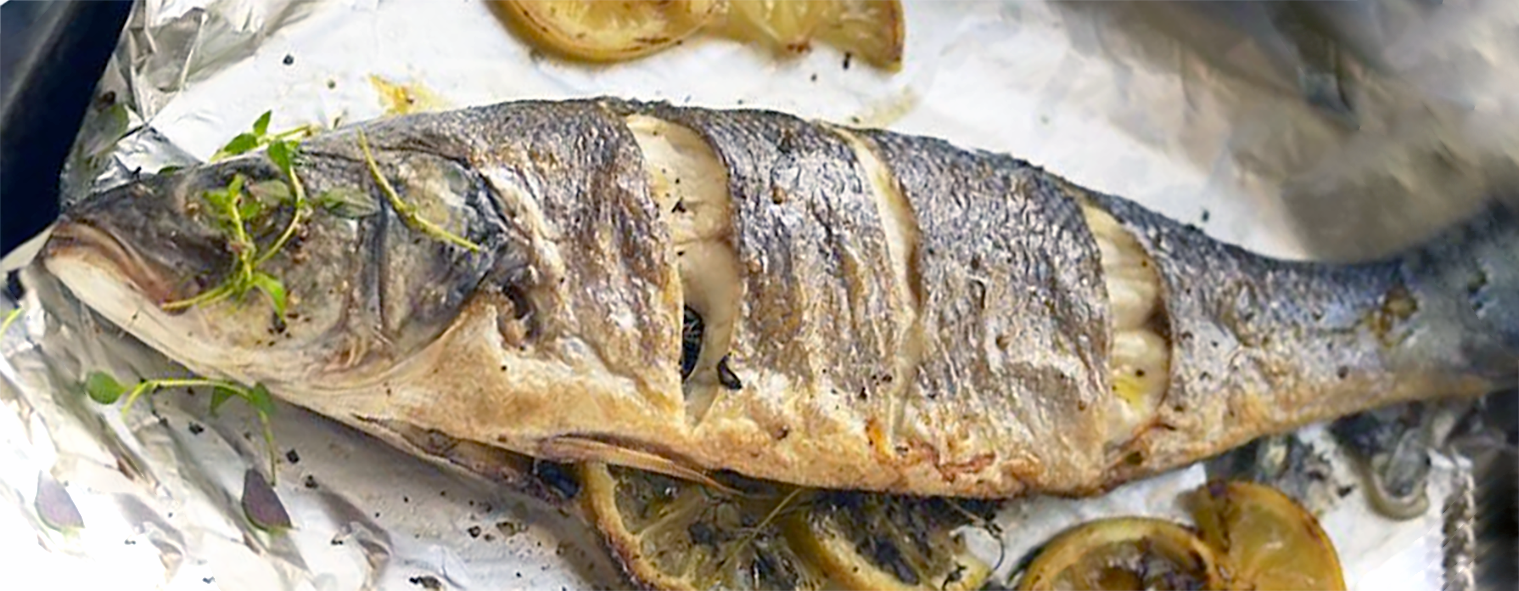FabulousFusionFood's Roasting Recipes 2nd Page
 A shoulder of lamb roasting on an Elizabethan-style spit (left) and in a modern oven, (right).
A shoulder of lamb roasting on an Elizabethan-style spit (left) and in a modern oven, (right).
Welcome to FabulousFusionFood's Roasting Recipes Page — This is a continuation of an entire series of pages that will, I hope, allow my visitors to better navigate this site. As well as displaying recipes by name, country and region of origin I am now planning a whole series of pages where recipes can be located by meal type and main ingredient. This page gives a listing of all the roasting recipes. The technique of roasting is perhaps the oldest cooking technique. After all you can roast meat by simply placing it in the embers of a fire or on hot stones or a pit. This is why the simplest way of cooking meat is to roast it. With modern ovens roasting has become a common and complex technique and roasting can be defined as a high temperature method of cooking over a prolonged period of time where the temperature about the product being roasted is even. Roasting is an excellent method of tenderizing meat, which is why it's a common technique for cooking meat. But it also works well for vegetables, especially potatoes and other staple carbohydrate sources. Being a simple cooking technique, roasting recipes are known from every culture and every major cuisine on earth.
Roasting is a cooking method that uses dry heat where hot air covers the food, cooking it evenly on all sides with temperatures of at least 150°C from an open flame, oven, or other heat source. Roasting can enhance the flavour through caramelization and Maillard browning on the surface of the food. Roasting uses indirect, diffused heat (as in an oven), and is suitable for slower cooking of meat in a larger, whole piece.[1] Meats and most root and bulb vegetables can be roasted. Any piece of meat, especially red meat, that has been cooked in this fashion is called a roast. Meats and vegetables prepared in this way are described as being 'roasted', e.g., roast chicken or roast squash.
Before the invention and widespread use of stoves, food was primarily cooked over open flames from a hearth. To roast meat, racks with skewers, or, if accessible, complicated gear arrangements, would be utilized to turn the piece(s). In the past, this method was often associated with the upper class and special occasions, rather than customary mealtimes, because it required freshly killed meat and close attention during cooking. It was easy to ruin the meat's taste with a smoky fire or negligence to rotate it at regular intervals. Thus, elite families, who were able to afford quality meat, appointed this task to servants or invested in technology like automatic turning devices. With further technological advances, cooking came to accommodate new opportunities. By the 1860s, working families were able to afford low-priced stove models that became sufficiently available. However, the key element of observation during roasting became difficult and dangerous to do with the coal oven. Hence, traditional roasting disappeared as kitchens became no longer equipped for this custom and soon thereafter, "baking" came to be "roasting".
 Roast fish (sea bass).
Roast fish (sea bass).
For roasting, the food may be placed on a rack, in a roasting pan or, to ensure even application of heat, may be rotated on a spit or rotisserie. If a pan is used, the juice can be retained for use in gravy, Yorkshire pudding, etc. During oven roasting, hot air circulates around the meat, cooking all sides evenly. There are several plans for roasting meat: low-temperature cooking, high-temperature cooking, and a combination of both. Each method can be suitable, depending on the food and the tastes of the people.
For more information on how best to roast various dishes, see this site's roasting guide.
The alphabetical list of all the roasting recipes on this site follows, (limited to 100 recipes per page). There are 354 recipes in total:
Page 2 of 4
| Forloren Hare (Danish Meatloaf) Origin: Denmark | Indian-spiced Leftover Christmas Roast Veg Origin: Britain | Leporem Farsum (Stuffed Hare) Origin: Roman |
| Fricassée of Turkey Origin: Britain | Isicia Ova et Cerebella (Egg and Brain Sausages) Origin: Roman | Leporem Madidum (Soaked Hare) Origin: Roman |
| Fried Chicken, Ital Vegetables and Rundown Sauce Origin: Jamaica | Item Aliam ad Eum Impensam (The Same Thing, With Other Ingredients) Origin: Roman | Leporem Passenianum (Hare à la Passenius) Origin: Roman |
| Frontinianum Porcellum (Suckling Pig Stewed in Wine) Origin: Roman | Iura Ferventia in Cervo (Hot Sauce for Venison) Origin: Roman | Leporem Pipere (Hare Sprinkled with Dry Pepper) Origin: Roman |
| Frontinianum Porcellum (Suckling Pig à la Fronto) Origin: Roman | Ius Album in Assum Leporem (Roast Hare in White Sauce) Origin: Roman | Llwynau Cig Oen Rhost (Roast Saddle of Welsh Lamb) Origin: Welsh |
| Fruit-glazed Easter Ham Origin: Britain | Ius diabotanon in pisce frixo (Fish in Herb Sauce) Origin: Roman | Lombo Enrolado (Stuffed and Rolled Pork Loin) Origin: Brazil |
| Fyletes in galyntyne (Fillets in a Sauce of Meat Juices) Origin: England | Ius Frigidum in Aprum Elixum (Cold Sauce for Boiled Wild Boar) Origin: Roman | Lomo de Cerdo Relleno (Stuffed Pork Loin) Origin: Spain |
| Gefüllte Weihnachtsgans (Christmas Goose) Origin: Germany | Ius Frigidum in Ovifero (Cold Sauce for Wild Sheep) Origin: Roman | Lumbuli assi ita fiunt (Stuffed Kidneys or Testicles) Origin: Roman |
| Glüehwein Roast Beef Origin: Germany | Ius in Aprum Elixum (Sauce for Boiled Wild Boar) Origin: Roman | Mackerel Stuffed with Samphire and Seasoned with Alexanders and Wild Fennel Seeds Origin: Britain |
| Glires (Stuffed Dormouse) Origin: Roman | Ius in Caprea Assa (Sauce for Roast Roebuck) Origin: Roman | Magret de Canard Rôti (Roast Duck Magret) Origin: France |
| Golwython Oen Cymreig (Welsh Lamb Chops) Origin: Welsh | Ius in Caprea Assa (Sauce for Roebuck, Another Way) Origin: Roman | Malardis Origin: England |
| Gruem vel anatem (Crane or Duck in Spiced Gravy) Origin: Roman | Ius in Cervo (Sauce for Venison) Origin: Roman | Mallorcan-style Easter Lamb Origin: Britain |
| Guard of Honour Origin: Britain | Ius in Cervum (Sauce for Venison) Origin: Roman | Mechoui (Dried-fruit Stuffed Leg of Lamb) Origin: Mauritania |
| Gwledd Gŵydd â Llenwad o Fricyll (Apricot-stuffed Festive Goose) Origin: Welsh | Ius in Cervum, Aliter (Sauce for Venison, Another Way) Origin: Roman | Mediterranean Lamb in a Dijon Mustard Sauce Origin: Mediterranean |
| Haedum Laseratum (Kid Goat Seasoned with Laser) Origin: Roman | Ius in Ovifero Fervens (Hot Sauce for Wild Sheep) Origin: Roman | Minted Racks of Lamb Origin: Canada |
| Haedum Laureatum ex Lacte (Suckling Kid Crowned with Laurel and Milk [Sausage]) Origin: Roman | Ius in Perdices (Sauce for Partridges) Origin: Roman | Moroccan Spice-rubbed Leg of Lamb Origin: Morocco |
| Haedum sive Agnum Parthicum (Parthian Kid or Lamb) Origin: Roman | Ius in Venationibus Omnibus (Sauce for all Kinds of Wild Game) Origin: Roman | Musakhkhan (Baked Chicken and Onions With Sumac) Origin: Palestine |
| Haedus sive Agnum Tarpeianum (Kid or Lamb à la Tarpeius) Origin: Roman | Jerked Gammon Cooked in Ginger Ale Origin: Jamaica | Mushroom-stuffed Chicken with Gravy Origin: Britain |
| Haedus sive Agnus Crudus (Seasoning for Raw Kid or Lamb) Origin: Roman | Jerked Leg of Goat Origin: Jamaica | Mustard Pork Loin Chops with Butternut Squash Roast Origin: Britain |
| Haggis and Pork Sausages with Mash and Red Wine Onion Gravy Origin: Scotland | Kahlua Baked Easter Ham Origin: American | Myma (Baked Plaice) Origin: Roman |
| Haggis Koftas Origin: Scotland | Kazakh Shashlik Origin: Kazakhstan | Nigerian Uziza Ribs Origin: Nigeria |
| Haggis-stuffed Chicken Cutlets Origin: Scotland | Kissuto Rombo (Baked Kid Goat) Origin: Sao Tome | North-Africa Style Breast of Lamb Origin: Fusion |
| Ham di Pasku (Easter or Holiday Ham) Origin: Aruba | Kleftiko (Lamb in the Oven) Origin: Cyprus | Ofellas Apicianas (Starters, Apician Style) Origin: Roman |
| Ham di Pasku (Easter or Holiday Ham) Origin: Bonaire | Kotmis Satsivi (Roast Chicken with Walnut Sauce) Origin: Georgia | Ofellas Ostienses (Ostian-style Starters) Origin: Roman |
| Ham di Pasku (Easter or Holiday Ham) Origin: Curacao | Kyrgyz-spiced Roast Chicken Origin: Kyrgyzstan | Orange-glazed Ham with Mustard Cream Origin: Canada |
| Hasselback Potatoes Origin: Britain | Lamb Stuffed with Chicken Origin: Montenegro | Oven-roasted Grey Snapper with Caribbean Sauce Origin: Turks Caicos |
| Haunch of Venison with Madeira Sauce Origin: Britain | Lamb Tikka Origin: India | Pado'lalo' (Spicy coconut Aubergine) Origin: Guam |
| Herb Crusted Cod Origin: Britain | Langouste à la Vanille (Lobsters with Vanilla Sauce) Origin: Comoros | Pado'lalo' (Spicy coconut Aubergine) Origin: Northern Mariana Islands |
| Howtowdie Origin: Scotland | Lechon (Roasted Pig) Origin: Philippines | Parmentier Potatoes Origin: France |
| Hwyaden Hallt Cymreig (Welsh Salt Duck) Origin: Welsh | Lechón (Puerto Rican Roast Pork) Origin: Puerto Rico | Parseli daenog y môr gyda pesto (Sea Bass Parcels with Pesto) Origin: Welsh |
| Hægeldaðir lambalæri (Slow-cooked Lamb Shanks) Origin: Iceland | Lechon Kawli (Oven-roasted Pork) Origin: Philippines | Patate e Finocchida Lucca (Roast Potatoes with Fennel Seeds) Origin: Britain |
| Impala Origin: eSwatini | Lemóni pshtó patátes (Greek Lemony Roasted Potatoes) Origin: Greece | Pavo de Navidad (Spanish-style Christmas Turkey) Origin: Spain |
| In Aprum Assum Iura Ferventia Facies Sic (Hot Sauce for Roast Wild Boar is Made Thus) Origin: Roman | Leporem Farsilem (Stuffed Hare) Origin: Roman | |
| Indian Dumpode Goose Origin: Anglo-Indian | Leporem Farsum (Stuffed Hare) Origin: Roman |
Page 2 of 4